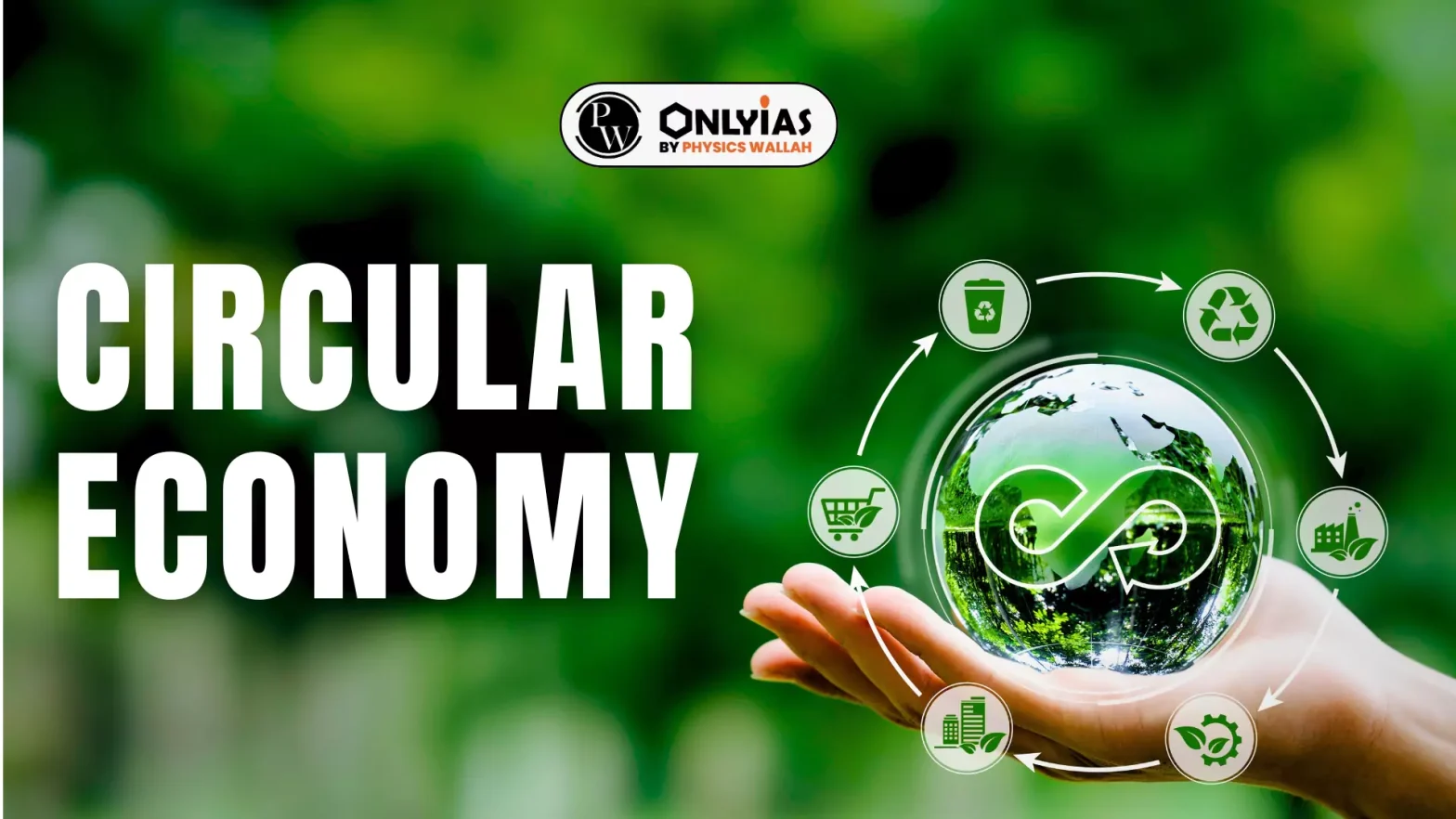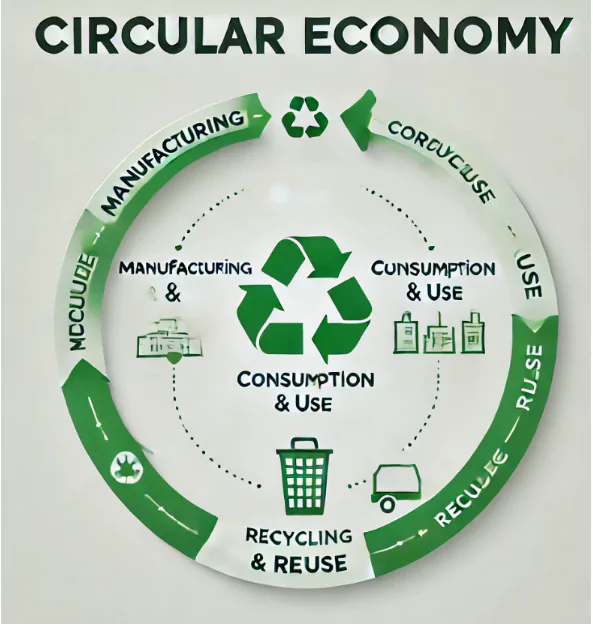Circular Economy is a sustainable economic model aimed at minimizing waste by reusing, recycling, and regenerating products. Learn more about it here.

The Circular Economy, also known as “circularity,” is a transformative concept that aims to rethink how we approach production, consumption, and waste management. Instead of the traditional “take-make-use-dispose” model, the circular economy promotes sustainability by extending the life cycle of products and encouraging resource efficiency. Explore the circular economy’s definition, importance, and benefits, specifically emphasizing its role in waste management.
The circular economy is a systemic approach to economic development aimed at eliminating waste and promoting the continual use of resources. Unlike the linear economy, which follows a “produce, use, dispose” model. The circular economy focuses on closing the loop of production and consumption by reducing, reusing, repairing, refurbishing, and recycling existing materials and products. The goal of the circular economy is to maintain the value of products and materials as long as possible, ensuring that resources remain within the economy instead of becoming waste.

Here’s an overview of the Seven Pillars of the Circular Economy and their role in creating a sustainable, regenerative economic system:
| Pillar | Description |
| Design for Durability and Longevity | Focuses on creating products that last longer and are easy to repair, reducing the need for replacements and minimizing waste. |
| Reduce, Reuse, and Recycle | Emphasizes reducing consumption, reusing products, and recycling materials to recover valuable resources for continuous use. |
| Refurbishment and Remanufacturing | Restores used products to like-new condition, from electronics to automotive parts, reducing the demand for new production. |
| Recovery and Regeneration | Involves recovering materials and energy from waste using technologies like recycling and waste-to-energy. |
| Product as a Service | Transitions consumers from ownership to access, promoting leasing and sharing models to reduce demand for physical products. |
| Sustainable Supply Chains | Minimizes waste and resource use across production and distribution, with a focus on sustainable material sourcing. |
| Digital Technologies and Data | Uses IoT and data analytics to track products and materials, improving resource efficiency and reducing waste through data-driven insights. |
The importance of the circular economy cannot be overstated in the face of rapid resource depletion, environmental pollution, and climate change. Traditional linear models contribute heavily to greenhouse gas emissions, deforestation, and landfills filled with non-biodegradable waste. In contrast, the circular economy fosters a more sustainable, efficient approach to production and consumption.
Adopting circular principles allows countries and businesses to meet sustainability targets and reduce their ecological footprint, creating a better future for generations to come.
Waste management is a key focus area for implementing circular economy practices. With urbanization and industrialization, waste generation has reached unprecedented levels, demanding innovative solutions. In the circular economy, waste is viewed not as a disposal problem but as a potential resource.
Key Practices in Circular Waste Management:
By implementing these strategies, the circular economy helps reduce the burden on landfills and promotes sustainable urban development.
For example, Amsterdam has been a pioneer in implementing circular practices in waste management. The city has set ambitious targets to reduce resource use by 50% by 2030, prioritizing building materials and electronic waste recycling. Amsterdam’s circular model has inspired other cities worldwide to adopt similar approaches, demonstrating the scalability of circular economy solutions.
The circular economy provides numerous benefits that go beyond environmental conservation, touching on economic and social aspects. By moving away from the traditional model, industries, and governments can enjoy advantages such as reduced costs, new business opportunities, and an improved quality of life.
Environmental Benefits:
Economic Benefits:
Social Benefits:
Incorporating these benefits, the circular economy supports sustainable development goals, benefiting the environment, society, and the economy.
For those preparing for competitive exams, especially the UPSC (Union Public Service Commission), understanding the circular economy meaning is crucial. The concept is relevant to topics in economics, environment, and governance, making it a common subject in the exam syllabus.
Understanding the circular economy’s principles and applications can help you tackle questions in both Prelims and Mains. Familiarity with case studies, government policies, and environmental impacts will allow you to write comprehensive answers. Here are some questions asked around
| Attempt UPSC Mains Question:
Q1. “What do you understand by the concept of circular economy? Explain. With the help of suitable examples, discuss some of the best practices of the circular economy model.” |
| Q2.”Analyse the potential of a circular economy approach in addressing the challenges of waste management and pollution in India. Also, suggest policy measures to strengthen the circular economy in India.” (10M, 150W) |
Sign up for the PWOnlyIAS Online Course by Physics Wallah and start your journey to IAS success today!
UPSC Exam 2025 Related Articles
UPSC Prelims 2025 Exam
UPSC Notification 2025
UPSC Preparation 2025
UPSC Eligibility 2025
UPSC Exam Pattern
UPSC Syllabus
The circular economy aims to extend the life cycle of products and materials, reduce waste, and promote sustainable resource use. By doing so, it minimizes environmental impact and conserves natural resources.
The linear economy follows a "take-make-dispose" model, whereas the circular economy emphasizes reducing, reusing, and recycling materials, thereby keeping resources in use for as long as possible.
The circular economy promotes efficient waste management by treating waste as a resource. It supports recycling, resource recovery, and waste-to-energy programs, reducing landfill dependency and pollution.
Examples include recycling plastic into new products, refurbishing electronics, composting organic waste, and producing energy from waste. Businesses may also adopt leasing or product-as-a-service models.
Governments can implement policies like Extended Producer Responsibility, promote recycling programs, and incentivize sustainable business practices through grants or tax benefits.

<div class="new-fform">
</div>
